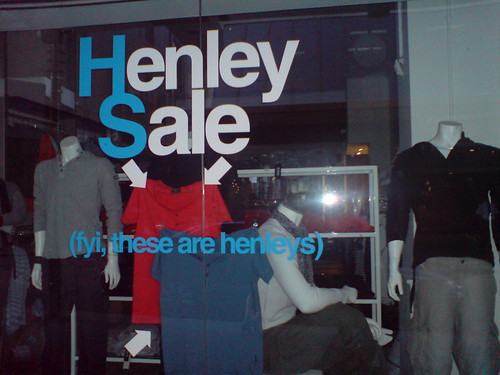
Back at the start of March, I was walking past the Industrie store on Little Collins Street and I noticed this striking window display. What struck me about it in particular was that it's not only performing a promotional role; it's also performing a pedagogical one. If you didn't know what a Henley shirt (sometimes called a Henley sweater) was, the Industrie shop window is prepared to teach you.
I myself am one of the educated, because I'd never heard the term "Henley" before I saw this display. I'm old enough to remember the last time they were popular, in the late 80s and early 90s, when they were called "grandpa shirts" because they looked like old-fashioned men's underwear. Back then they were part of the underwear-as-outerwear grunge ethos. I used to wear them with a contrasting coloured t-shirt underneath, then I'd roll up the sleeves to reveal the under-layer.
But I digress. Last week I noticed that Dotti on Swanston Street is also doing this shop-window pedagogy.

While it's another total digression, perhaps this is a good opportunity to mention that, while I'm pleased to have predicted the current resurgence of 60s mod fashion back in 2005, it gives me fresh insight into why my plump aunt is scowling and looking uncomfortable in most of the family photos taken in the 60s. Just like the first time round, it's disappointingly unflattering on all but the most Twiggy-like figures. Sack-like dresses and tops that hang from a yoke just above the bust (looks fine on flat-chested women, whereas bosomy lasses look pregnant). Prim high necklines and the return of skivvies under pinafores (like I used to wear in primary school!). Low-cut slouch boots that sit right on (or even just below!) the ankle and look ludicrously stumpy on anyone without long willowy legs. Dull drab greys and mustards and burgundies and olives. Not jaunty at all.
But anyway. The thing that intrigues me about the Dotti display is that it's teaching customers how to wear the clothes. Shopping is in fact an assemblage of teachings; shop-window visual merchandising is only the first and most striking, intended to pull you into the store. Once you're in there they continue to teach you how to wear the clothes by directing you through carefully arranged space, and getting you to interact with the shop assistants, who model and personify the brand (Supre and Alannah Hill are two particularly coherent examples of this) and, more obviously, who give you advice on how to fit and combine the clothes.
Many stores also produce literature ("magalogues" and websites) to extend their pedagogies beyond the physical retail space. These are another issue for me, because what I find interesting is the way the experience of the retail space is meant to educate. The point of this post is what's at stake for the brands in performing this role.
Most obviously, they are attempting to mould brand loyalty - to teach shoppers how to interpret fashion trends through the lens of the brand's particular ethos. Rather than tailoring their offerings to a pre-existing 'market' (eg tweens, edgy corporate wear), I think many brands try to create their market by teaching young, inexperienced clothes shoppers particular tastes and techniques that will thereafter shape their consumer practices.
But of course, that's not the entire story. We're all subject to many competing influences on our fashion consumption - popular culture (music, film, TV, etc); fashion magazines and blogs (some of which are explicitly pedagogical, eg "How to wear the new pencil skirt"); what we see other people wearing, and pleasurable feelings we get from particular garments (the swishiness of a full skirt; the fluffiness of a cashmere scarf; the clippiness and shininess of new shoes).
Perhaps what these displays are trying to bestow is a rubbed-off positive affect from having bestowed the gift of cultural capital. Sure, I might not have known what a Henley was, but now I do, and it was Industrie that taught me. Thanks, Industrie - now I will buy your garments. My phrasing is facetious, but let's not forget Miriam Silvester's idea of fashion levels - many people want to appear fashionable but don't actively follow trends. So there's money to be made by teaching them about the trends in such a way that they associate the teacher (the brand) with the pleasure of feeling newly fashionable - even if they don't actually buy the clothes.